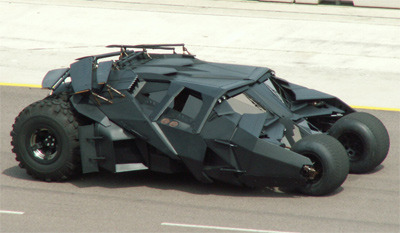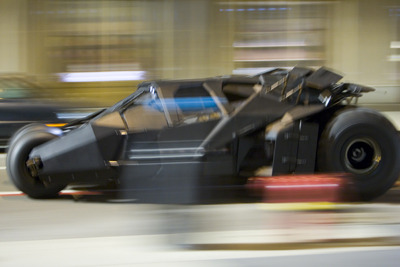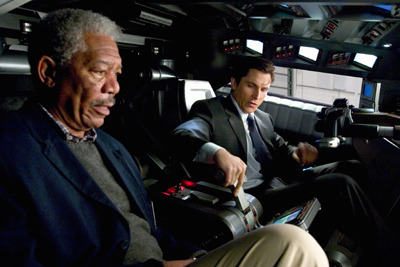Appearing static as part of a broader Warner/DC promotional Campaign at the London Film & Comic Convention, these photos depict ‘the’ awesome Tumbler Batmobile, from the film Batman Begins. There seemed to be a lack of information surrounding the Tumbler, both at the DC area and on the Showmasters forum but that is probably because this is not ‘the’ Tumbler. The Tumbler itself is an illusion. The car at LFCC may well be a glorious piece of it, but as to which piece, well that dear reader is a riddle suitable for the Batman himself.
Or indeed the Bugwriter, man.
I thought I’d do some sleuthing on our behalf. Besides talking to people at the con, all the information contained in this article comes from websites and media interviews with members of the production team, led by production designer Nathan Crowley. So you can easily verify it for yourself, if you should so desire. In the interviews I have read, Crowley has stated that he has provided an understanding of the process of making the Tumbler in order to enable a greater appreciation of why modern film cost so much money to create. Crowley is a realist, and demanded a solid physical functioning Batmobile, rather than a computer enhanced representation.
I am led to believe by the Warner/DC Rep that this is the genuine article, and that the vehicle was original designed for military use. However, the Tumbler that you see in the movie Batman Begins is actually a collection of at least eight different versions of the same car, its origin is closer to Airfix that Air Force, so why don’t you and I put the pieces together huh? Many people I spoke to at the LFCC scoffed when I suggested that the idea of the One True Tumbler was an illusion. But now you can make up your own mind, because I’m here to give you the low down on the car the chicks love the most.
To begin with lets get the official line from the movie, taken from DVD extras:
Originally an all terrain bridging vehicle, designed for military use, the Tumbler is the perfect tool for urban warfare in Gotham City. With stealth aided angled panels that deflect radar tracking and infer red thermal imaging, it is a technological tour de force, able to protect itself and its allies against enemy attacks.
Equipped with inverted spoiler airfoils, the vehicle can jump ramp less across lengthy spans. Rocket propelled tow cables allow for dramatic breaking to a dead stop, no matter what the speed. It is equipped with cannons in the nose, that fire standard ballistics as well as a variety of non lethal rounds like sticky foam…
Holy pocket rockets Batman!
A car that shoots sticky foam, and then avoids your phone calls. It’s the perfect accessory for Batman, the consummate bat-choler, who doesn’t really have any super powers and needs a car to get around and kick some ass.
The car that you see is both performer in the film and character in the story. It has its own factual back story and fictional history. In so far as it extends human action and mediates communication between people, the Tumbler may be considered a social agent, essentialy Batmans co-star.
The Tmbler began life as a whole mess of 1:12 model kits. Regular airfix style kits are often cannibalized for parts by production teams looking to build unique or complex sale models. The process is termed kit bashing, or model bashing. For all you beatniks out there, it’s the model building equivalent of the cut-up method. You can now recognize the jet engine at the Tumblers rear, as originally a nose cone from a P38 lightning fighter model kit.
Over the course of four months, Crowley built six 1:12 scale models. From these a team of over thirty engineers, spent two months carving a full scale Styrofoam model. By creating a full scale replica, the team was able to hand make the wooden body panel moulds, from which the sixty five body panelswould be cast. A steel test frame was also cast from the Styrofoam model.
The steel test frame was put through some rigorous procedures. It was given a 5.7 litre Chevorlete V-8 Engine and a special breaking system. It was made to travel at over one hundred miles an hour and tuned to accelerate from 0-60 in five seconds. In order to make tight turns, extra brakes were added at the rear, controlled by large hand leavers. In principal, this is the same kind of breaking system that is used on tractors.
At nine feet four inches wide, (284cm) the frame was 8 inches (20cm) bigger than those large US 18 Wheel trucks. The test frame’s rear axle and transmission comes from such a truck, adding significant weight to the 5,000lb vehicle, which had to be able to safely jump thirty feet in the air without serious damage. On the first jump test the entire front end collapsed and had to be rebuilt from scratch, yet the weighty axle remained key to the rugged design of the vehicle.
The rear tyres are thirty seven inches in diameter, commercially purchasable, 4x4 mud tyres called Swampers, manufactured by Interco. Front tyres are racing tyres, manufactured by Hoosier. The front wheels suspension has independent elements which enable the front wheels to extend thirty inches in order to absorb the jumps it makes. The process of building the test frame took nine moths and cost several million dollars. From the working test frame, the team were able to begin assembly line production on four street ready race cars.

These are the cars that you see racing around in the film. Outside they look like Batmobiles, but inside, they resemble NASCAR race cars. They have a steel roll cage, exposed gauges, riveted steel panelling, Halon fire extinguishing systems and other safety features. The cars have limited side and rear visibility, so monitors were installed to enable the driver to see around the vehicle. Because of all the unique specifications, drivers trained for six months before filming began.
So why build four? With these stunt cars travelling at 100 miles an hour, being braked by huge levers and bouncing thirty feet into the air, naturally it pays to have a spare. Furthermore, two of the Bat-NASCARS had specifications for certain shots. One was the ‘flap car’ kitted out with special hydraulics and flaps, the other was the ‘flame car’ which had a removable jet engine fuelled by six propane tanks. Each of these four vehicles cost a quarter of a million dollars each.

None of these cars are used in the close up shots, where Batman gets in and out of the vehicle. For these scenes, another vehicle, the ‘arrival car’ was built and rigged with the hydraulics necessary to make the car open and close in a unique way. This is the car you see Batman pulling up in. Rather than a powerful V8 engine, this fifth vehicle has an electric motor which enables it to move forward into position. The motor is controlled by another driver, who is hidden inside the vehicle.
When we see inside the vehicle, we actually look upon another Batmobile, an oversized static studio set, an official interior, built bigger to fit the cameras inside. Finally there is one more version of the Batmobile, a six foot long, motorized 1:5 model, which we see flying between ravines and rooftops in the film. When you see the Tumbler flying through the air, that is usually miniature version, intercut with shots of the “flap version” of the full-sized car.

So to recap, first came the original kitbashed model/s. From these, a scale model was created from Styrofoam. From this, a prototype steel test frame was fabricated enabling four NASCAR style race cars to be built, one flap version and one Jet version. A further hydraulic opening vehicle the ‘arrival car’ was then made, with a more realistic interior. For the airborne scene, it became necessary to create a miniature replica, and for the close up interiors a static studio set was made.
I count at least eight Batmobiles in there, designed and constructed by several different teams of engineers containing dozens of people, taking many months and costing many millions of dollars in research, development and fabrication. What you have seen at LFCC is a piece of an illusion. Without a doubt an impressive sight, but a fabrication of the truth none the less. In politricks smoke and mirror bullshit often hides the reality of the situation. The reality of this situation was that the Tumbler took away the attention from a poor DC exhibition, which featured two shop dummies and a meager suitcase display of a few rather sad looking props.
It seems almost criminal for this wonderful piece of memorabilia to guest at LFCC with out any information, or worse, with the wrong information, when we could of had Tumbler talks and demos. What you saw at LFCC is a production made street racer, probably one of the Bat-NASCARS. This way DC can tour more than one exhibition at the same time. Without doubt it is a fantastic sight and am greatful to all those who made its appearence possible. If anybody has seen any different versions, or if you saw this one open up, and a frakkin’ Batman get out, or if there was some Batmobile talk that I missed, or you witnessed it arrive or driving around please get in touch.
Originally there was a video of the nascar tumbler attached to this post that I took at the LFCC. Its a clear walk around the vehicle, before the crowds arrived. Untilll I can re post it here, please check it out in my tumblr blog at bugwriter.tumblr.com
Ever wondered about the life of George Barris, the man who made the 1966 original Batmobile from a Lincon Futura? Or mused about where you could buy a Batmobile? Or how to make one? Well the Bugwriter can hook you up…stay Tuned Batfans, more Batmobile talk to follow
No comments:
Post a Comment